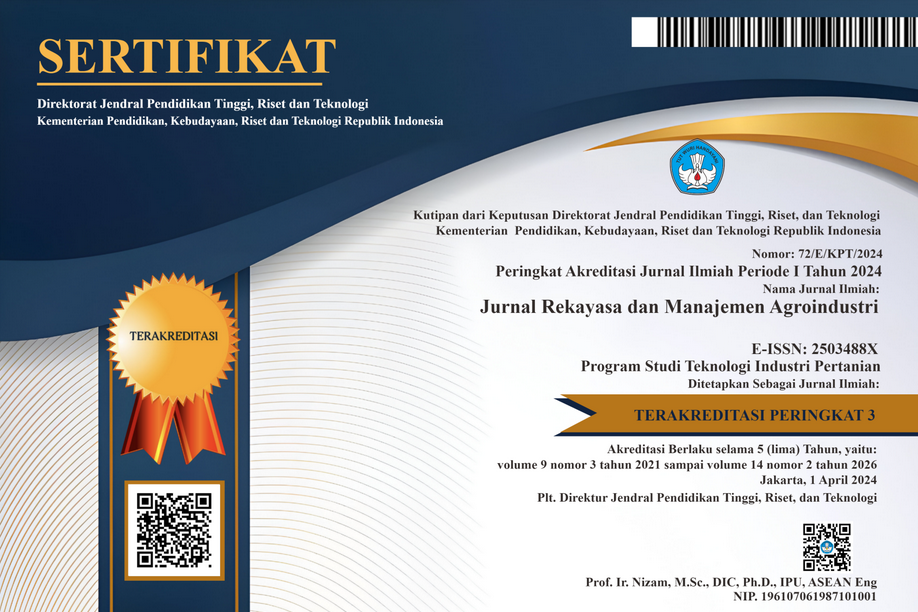Karakteristik Komposit Biotermoplastik Berbasis Pati Termoplastis/ Glukomanan Termoplastis/Poli Asam Laktat Dalam Variasi Jenis Dan Konsentrasi Filler
Abstract
ABSTRACT
Biothermoplastic composites are eco-friendly materials that degrade more quickly. These composites are a mixture of biologically-based polymers that melt when heated and solidify when cooled, making them a potential solution for sustainable packaging materials. This study aims to determine the effect of various types and concentrations of fillers on the characteristics of biothermoplastic composites, as well as to identify the combination of filler type and concentration that produces the best characteristics in thermoplastic starch/thermoplastic glucomannan/polylactic acid (TPS/TPG/PLA) composites. The research used a Completely Randomized Design (CRD) factorial with the first factor being the type of filler (J), namely ZnO, Clay, and CaCO?, while the second factor was the filler concentration (K), which was 5%, 7.5%, and 10% of the matrix material. Therefore, there were 9 treatment combinations, each repeated twice. The variables observed in this study were tensile strength, elongation at break, elasticity (Young's modulus), swelling, density, melting point, and biodegradation time. The data obtained were analyzed using variance analysis and followed by the Honest Significant Difference (HSD) test. The results showed that the type and concentration of filler had a significant influence on tensile strength, elongation at break, elasticity, swelling, density, melting point, and biodegradation time. The best biothermoplastic composite was obtained using 10% clay filler, with a tensile strength of 41.88 MPa, elongation at break of 0.68%, elasticity of 6.16 GPa, swelling of 0.48%, density of 1.01 g/cm³, a melting point of 170.05°C, and a biodegradation time of 24.5 days. The characteristics of the TPS/TPG/PLA biothermoplastic composite mostly meet SNI and international standards, except for elongation at break.
Keywords: biothermoplastic composite, thermoplastic starch, thermoplastic glucomannan, polylactic acid, filler
ABSTRAK
Komposit biotermoplastik, yakni material ramah lingkungan yang dapat terurai lebih cepat. Komposit ini merupakan campuran polimer berbasis bahan biologis yang meleleh saat dipanaskan dan mengeras kembali saat didinginkan, menjadikannya solusi yang potensial sebagai bahan kemasan berkelanjutan. Penelitian ini bertujuan mengetahui pengaruh dari beberapa jenis dan konsentrasi filler terhadap karakteristik komposit biotermoplastik, serta menentukan kombinasi jenis dan konsentrasi filler yang menghasilkan karakteristik terbaik dari komposit biotermoplastik pati termoplastis/glukomanan termoplastis/poliasam laktat (TPS/TPG/PLA). Penelitian ini menggunakan Rancangan Acak Lengkap (RAL) factorial dengan faktor pertama jenis filler (J) yaitu ZnO, Clay, CaCO3 sedangkan faktor kedua yaitu konsentrasi filler (K) sebesar 5, 7.5 dan 10% dari bahan matrik. Oleh karena itu, terdapat 9 kombinasi perlakuan yang masing-masing diulang dua kali. Variabel yang diamati pada penelitian ini yaitu kuat tarik, perpanjangan saat putus, elastisitas, pengembangan tebal, densitas, titik leleh dan waktu biodegradasi. Data yang diperoleh dianalisis menggunakan analisis keragaman dan dilanjutkan dengan uji Beda Nyata Jujur (BNJ). Hasil penelitian menunjukkan bahwa jenis dan konsentrasi filler memiliki pengaruh yang sangat signifikan terhadap kuat tarik, perpanjangan saat putus, elastisitas, dan pengembangan tebal, densitas, titik leleh dan waktu biodegradasi Komposit Biotermoplastik terbaik diperoleh oleh komposit biotermoplastik yang menggunakan filler clay 10% dengan nilai kuat tarik 41,88 MPa, nilai perpanjangan saat putus 0,68%, elastisitas 6,16 GPa, pengembangan tebal 0,48%, densitas 1,01 g/cm3, titik leleh 170,05oC dan waktu biodegradasi 24,5 hari. Karaketeristik komposit biotermoplastik TPS/TPG/PLA sebagian besar telah standar SNI dan internasional, kecuali perpanjangan saat putus.
Kata kunci : komposit biotermoplastik, pati termoplastis, glukomanan termoplastis, poliasam laktat, filler
Downloads
References
Amni, C., Marwan, M., dan Mariana, M. 2015. Pembuatan Bioplastik Dari Pati Ubi Kayu Berpenguat Nano Serat Jerami dan ZnO. Jurnal Litbang Industri, 5(2), 91. https://doi.org/10.24960/jli.v5i2.670.91-99. Diakses pada November 2023.
Ayu, N., Jumiati, E., dan Husnah, M. 2023. Analisis Uji Mekanik Bioplastik Berbahan Pati Tepung Sagu- Kitosan Dan Sorbitol. Journal Online of Physics, 8(3), 47–50. https://doi.org/10.22437/jop.v8i3.23332. Diakses pada November 2023.
Dang, K. M., dan Yoksan, R. 2015. Development of thermoplastic starch blown film by incorporating plasticized chitosan. Carbohydrate Polymers, 115, 575–581. https://doi.org/10.1016/j.carbpol.2014.09.005. Diakses pada November 2023.
Darni, Y., Sitorus, T. M., dan Hanif, M. 2014. Produksi Bioplastik dari Sorgum dan Selulosa Secara Termoplastik Thermoplastic Processing of Sorghum and Cellulose to Produce Bioplastics. Rekayasa Kimia Dan Lingkungan, 10(2), 55–62.
Fibriyani, D. 2017. Pengolahan Onggok Singkong Sebagai Plastik Biodegradable Menggunakan Plasticizer Gliserin Dari Minyak Jelantah. Jurnal Aplikasi Teknologi Pangan, 6(2). https://doi.org/10.17728/jatp.195. Diakses pada November 2023.
Harsojuwono, B. A., Arnata, I. W., Hartiati, A., Setiyo, Y., Hatiningsih, S., dan Suriati, L. 2022. The Improvement of the Modified StarchGlucomannan—Polyvinyl Alcohol Biothermoplastic Composite Characteristics With Polycaprolactone and Anhydride Maleic Acid. Frontiers in Sustainable Food Systems, 6(4), 1–13. https://doi.org/10.3389/fsufs.2022.844485. Diakses pada November 2023.
Jambeck, J. R., Geyer, R., Wilcox, C., Siegler, T. R., Perryman, M., Andrady, A., Narayan, R., Law, K. L. 2015. Plastic waste inputs from land into the ocean. Science, 347(6223), 768–771. https://doi.org/10.1126/science.1260352. Diakses pada November 2023.
Lailiyah, Q., Lailiyah, Q., Baqiya, M. A., Darminto, D. 2012. Pengaruh Temperatur dan Laju Aliran Gas CO2 pada Sintesis Kalsium Karbonat Presipitat dengan Metode Bubbling. Jurnal Sains Dan Seni ITS, 1(1), B6–B10. http://ejurnal.its.ac.id/index.php/sains_seni/article/view/287%0Ahttps://ejurnal.its.ac.id. Diakses pada November 2023.
Limbong, S. F., Harsujuwono, B. A., dan Hartiati, A. 2022. Pengaruh Konsentrasi Polivinil Alkohol dan Lama Pengadukan pada Proses Pemanasan terhadap Karakteristik Komposit Biotermoplastik Maizena dan Glukomanan. Jurnal Ilmiah Teknologi Pertanian Agrotechno, 7(1), 37–46.
Liu, C., Wang, R. R., Ho, I., Kong, Z. J., Williams, C., Babu, S., Joslin, C. 2023. Toward online layer-wise surface morphology measurement in additive manufacturing using a deep learning-based approach. Journal of Intelligent Manufacturing, 34(6), 2673–2689. https://doi.org/10.1007/s10845-022-01933-0. Diakses pada November 2023.
Maulana Faizal. 2014. Pengaruh Komposisi Glukomanan-Tapioka Terhadap Karakteristik Biopolimer Sebagai Plastik Ramah Lingkungan. Institus Teknologi Sepuluh November.
Morales, A., Güemes, A., Fernandez-Lopez, A., Carcelen Valero, V., dan De La Rosa Llano, S. 2017. Bamboo–Polylactic Acid (PLA) Composite Material for Structural Applications. Materials, 10(11), 1286. https://doi.org/10.3390/ma10111286. Diakses pada November 2023.
Nafchi, A. M., Nassiri, R., Sheibani, S., Ariffin, F., dan Karim, A. A. 2013. Preparation and characterization of bionanocomposite films filled with nanorod-rich zinc oxide. Carbohydrate Polymers, 96(1), 233–239. https://doi.org/10.1016/j.carbpol.2013.03.055. Diakses pada November 2023.
Sudirman, Aloma, K. K., Gunawan, I., Handayani, A., dan Hertinvyana, E. 2002. Sintesis Dan Karakterisasi Komposit Polipropilena/Serbuk Kayu Gergaji. Jurnal Sains Materi Indonesia, 4(1), 20–25.
Zhang, L., Wang, Z. 2013. Effect Of Filler Types And Contents On The Mechanical Properties Of Biocomposite Materials. Journal Of Materials Science, 48(6), 2108–2117.

Ciptaan disebarluaskan di bawah Lisensi Creative Commons Atribusi-BerbagiSerupa 4.0 Internasional.
Seluruh artikel di Jurnal ini dapat disebarluaskan atas tetap mencantumkan sumber yang syah. Identitas judul artikel tidak boleh dihilangkan. Penerbit tidak bertangggung jawab terhadap naskah yang dipublikasikan. Isi artikel menjadi tanggung jawab Penulis.














